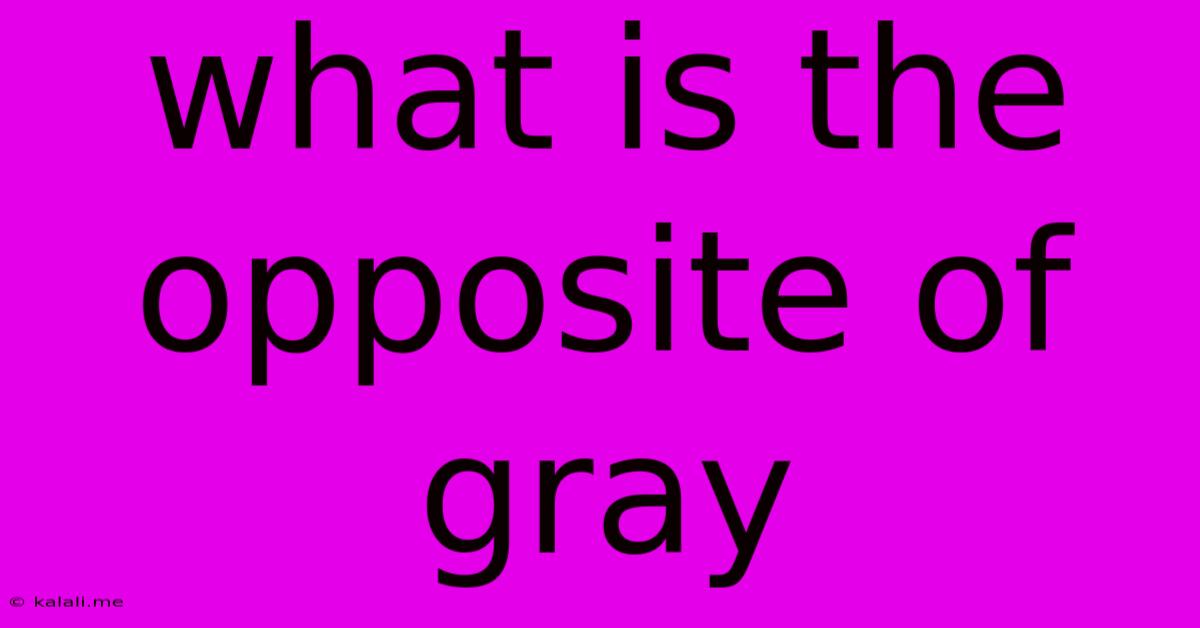What Is The Opposite Of Gray
Kalali
Jun 09, 2025 · 2 min read

Table of Contents
What is the Opposite of Gray? It's More Than Just Black and White
The seemingly simple question, "What is the opposite of gray?" reveals a surprising depth. While the immediate answer might be black or white, a deeper exploration reveals a nuanced answer dependent on the context. This article delves into the various interpretations and explores the multifaceted nature of color opposites.
Meta Description: Uncover the surprisingly complex answer to "What is the opposite of gray?" We explore the various perspectives, from simple black and white to more nuanced interpretations based on color theory and context.
The most straightforward answer lies in the basic color wheel. Gray, being a neutral color, sits in the middle, representing a balance between light and darkness. Therefore, black and white could be considered opposites, representing the extremes of the light spectrum. However, this is a simplified view.
Considering Complementary Colors
In color theory, complementary colors sit opposite each other on the color wheel. They create a high contrast when placed side-by-side. However, gray doesn't have a single direct complementary color in the same way that, say, red has green. Because gray is achromatic (lacking hue), applying the concept of complementary colors is less straightforward.
Vibrancy as a Counterpoint
Instead of focusing on a specific color, we can consider the quality of gray. Gray is often associated with dullness, neutrality, and a lack of vibrancy. Therefore, the opposite of gray could be described as vibrant, bright, or saturated. This approach shifts the focus from specific hues to the overall intensity and saturation of color.
Psychological and Emotional Associations
The meaning of "opposite" can also be subjective. Gray often evokes feelings of dullness, boredom, or uncertainty. In this context, the opposite might be represented by colors associated with energy, excitement, or clarity, such as bright yellows, passionate reds, or calming blues. The choice depends on the specific emotion you want to counter.
Context Matters: The Role of Gray in Design
The appropriate "opposite" of gray also depends on its application. In graphic design, gray is often used as a neutral background. In this context, the opposite might be a bold color used for text or accents, aiming for maximum contrast and readability. It’s less about a specific color and more about achieving visual impact.
Beyond the Visual: Exploring Abstract Opposites
Thinking outside the box, we could even explore abstract opposites. If gray represents ambiguity or indecision, its opposite could be certainty, clarity, or decision. This perspective transcends the visual realm and explores the conceptual connotations associated with the color.
In conclusion, there's no single definitive answer to "What is the opposite of gray?" The appropriate opposite depends heavily on the context. Whether it's the stark contrast of black and white, the vibrancy of saturated colors, or the emotional counterpoint of exciting hues, the answer is multifaceted and reflects the complex nature of color perception and interpretation.
Latest Posts
Latest Posts
-
Why Does My Bed Creak When I Move
Jun 09, 2025
-
When Atc Calls For Gaurd What Does That Mean
Jun 09, 2025
-
Chacos Toe Strap Or No Toe Strap
Jun 09, 2025
-
How To Check A Fuel Pressure Regulator
Jun 09, 2025
-
I Am The Lord Thy God
Jun 09, 2025
Related Post
Thank you for visiting our website which covers about What Is The Opposite Of Gray . We hope the information provided has been useful to you. Feel free to contact us if you have any questions or need further assistance. See you next time and don't miss to bookmark.